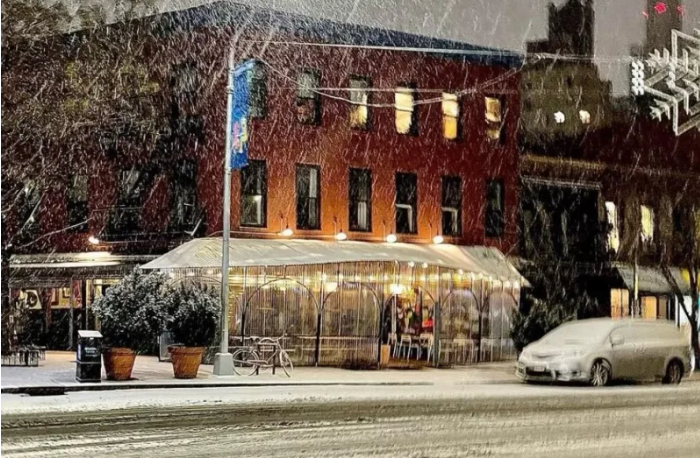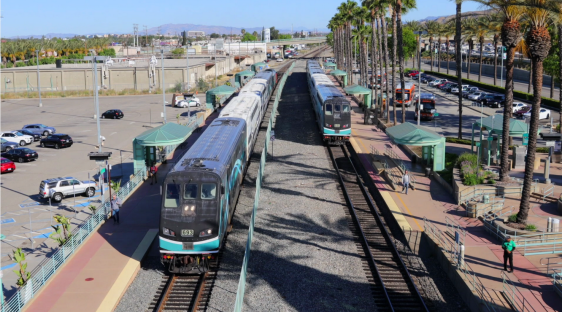The City Council is expected to vote this month on a bill regulating the Covid-era Open Restaurant program. Restaurateurs want the final bill to allow for dining areas to be in the roadway all year long, as opposed to the current bill, which says outdoor dining will only be seasonal. Here’s the opinion of a Brooklyn restaurant owner.
My restaurant is Chez Oskar, a French bistro and a Brooklyn staple since 1998. Pre-Covid, we had no right to put out tables or chairs. Try as we might, we had no luck and we weren’t alone. Then the pandemic hit, and a miracle happened: New York City was allowed to dine outdoors!
We wanted ours to be spectacular, the place to meet and reconnect safely. It had to be affordable, strong, durable, and as beautiful as we could imagine. We decided on curvy Art Nouveau steel structures and clear covers with maximum site lines taking up minimum space on the road or sidewalk. We found a modular system that made for minimum waste. Lighting helped make our corner safer and the covers made for consistent business: rain, shine or snow. Consistent capacity brought not only our staff back, but we also had to hire more and our business finally had hope to survive.
( function() {
var func = function() {
var iframe = document.getElementById('wpcom-iframe-ddf890e517e5a68a859e94667066b876')
if ( iframe ) {
iframe.onload = function() {
iframe.contentWindow.postMessage( {
'msg_type': 'poll_size',
'frame_id': 'wpcom-iframe-ddf890e517e5a68a859e94667066b876'
}, "https://embeds.streetsblog.org" );
}
}
// Autosize iframe
var funcSizeResponse = function( e ) {
var origin = document.createElement( 'a' );
origin.href = e.origin;
// Verify message origin
if ( 'embeds.streetsblog.org' !== origin.host )
return;
// Verify message is in a format we expect
if ( 'object' !== typeof e.data || undefined === e.data.msg_type )
return;
switch ( e.data.msg_type ) {
case 'poll_size:response':
var iframe = document.getElementById( e.data._request.frame_id );
if ( iframe && '' === iframe.width )
iframe.width = '100%';
if ( iframe && '' === iframe.height )
iframe.height = parseInt( e.data.height );
return;
default:
return;
}
}
if ( 'function' === typeof window.addEventListener ) {
window.addEventListener( 'message', funcSizeResponse, false );
} else if ( 'function' === typeof window.attachEvent ) {
window.attachEvent( 'onmessage', funcSizeResponse );
}
}
if (document.readyState === 'complete') { func.apply(); /* compat for infinite scroll */ }
else if ( document.addEventListener ) { document.addEventListener( 'DOMContentLoaded', func, false ); }
else if ( document.attachEvent ) { document.attachEvent( 'onreadystatechange', func ); }
} )();
The structures’ broad “brims” were deliberate: a safe space for pedestrians from rain and for our staff to not get wet and catch Covid. We cooled in summer with water misters, and heated in winter with pellet stoves and electric radiant heat. We grew veggies, flowers, and vines all over the structures, using rain runoff to water plants. In two short years of fighting Covid, we built a sustainable ecosystem for all to co-exist and congregate: neighbors read morning newspapers and drink their coffees in our structures before opening; we feed panhandlers between rushes; pedestrians, servers and diners seek shelter here when it rains alike. Our corner is lush and green like it never was.
And now after only one hearing, the City Council is to vote on the outdoor dining program.
The most destructive changes are to make roadside seasonal and outdoor dining without covering. Intentional or not, it will kill many small businesses: Imagine storing roadside structures somewhere (there is no place to store them actually) only to pull it out again four months later — and imagine over 10 000 restaurants trying to do that at the same time! Imagine the jobs on hold and revenue lost over months and imagine the Covid numbers going up while seats disappear and businesses shutter because they cannot survive serving without reliable capacity.
Where are busboys, waiters, runners, and managers to go during winter months or when it rains? We lost half of our industry in the last pandemic.
The animation above of a real covered structure in Bedford-Stuyvesant has helped us survive and serve our community in unique and effective ways. This is a plea for dialogue. Instead of concentrating on bad actors that make for clickbait, hear us out. You can regulate bad actors without killing the program.
Let’s reimagine safer, cleaner, greener streets, thriving businesses with creative structures powered by renewable energy, ready to serve their communities no matter how many pandemics strike. Let’s open the door to innovative ideas and solutions to re-social and redefine how we share public space safely! Permanent, well-regulated, covered year-round roadside and sidewalk dining are imminent for the recovery not only of our industry but for the recovery of New York City and its future as a diverse multicultural city with thriving small businesses.





